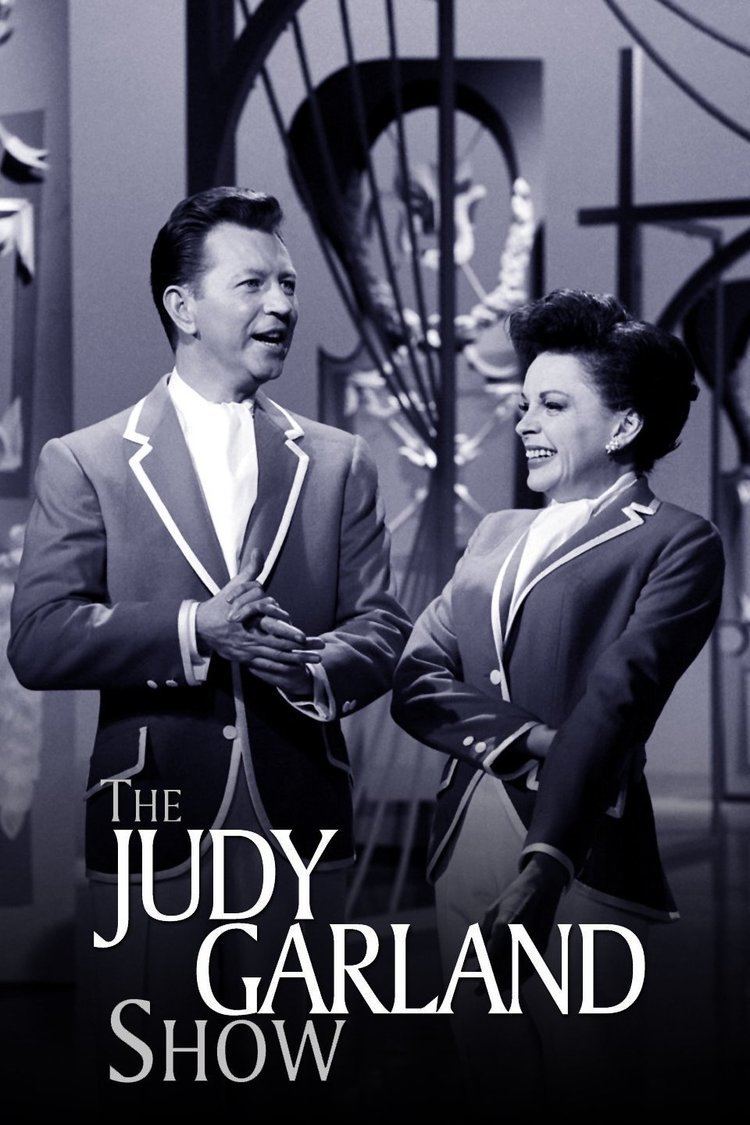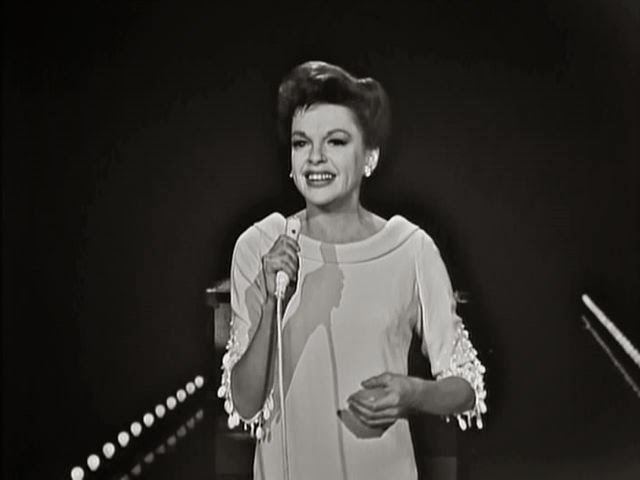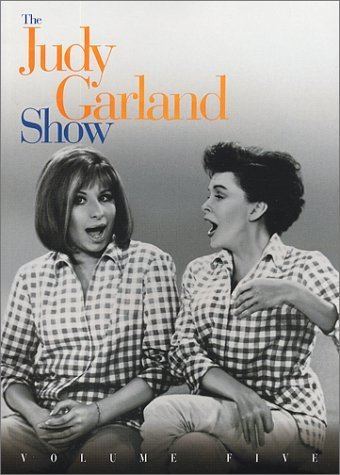8 /10 1 Votes8
7.1/10 TV Country of origin United States First episode date 29 September 1963 | 9/10 IMDb No. of episodes 26 Final episode date 29 March 1964 | |||||||||||||||||||||||||||||||||
 | ||||||||||||||||||||||||||||||||||
Written by John AylesworthFrank PeppiattMel Tormé Starring Judy GarlandJerry Van Dyke Similar The Dean Martin Show, The Danny Kaye Show, The Dinah Shore Chevy Sh, The Carol Burnett Show, The Ed Sullivan Show | ||||||||||||||||||||||||||||||||||
The judy garland show episode 4
The Judy Garland Show was an American musical variety television series that aired on CBS on Sunday nights during the 1963-1964 television season. Despite a sometimes stormy relationship with Judy Garland, CBS had found success with several television specials featuring the star. Garland, who for years had been reluctant to commit to a weekly series, saw the show as her best chance to pull herself out of severe financial difficulties.
Contents
- The judy garland show episode 4
- The judy garland show episode 9
- Garland and CBS
- Production
- The George Schlatter episodes Episodes 1 5
- The Norman Jewison episodes Episodes 6 13
- The Bill Colleran episodes Episodes 14 26
- On the air
- DVD releases
- Box set releases
- References

Production difficulties beset the series almost from the beginning. The series had three different producers in the course of its 26 episodes and went through a number of other key personnel changes. With the change in producers also came changes to the show's format, which started as comedy/variety but switched to an almost purely concert format.

While Garland herself was popular with critics, the initial variety format and her co-star, Jerry Van Dyke, were not. The show competed with Bonanza, then the fourth most popular program on television, and consistently performed poorly in the ratings. Although fans rallied in an attempt to save the show, CBS cancelled it after a single season.
TV Guide included the series in their 2013 list of 60 shows that were "Cancelled Too Soon".
The judy garland show episode 9
Garland and CBS
Garland's history with CBS prior to the series was a checkered one. She had previously headlined several specials for the network. The first was the inaugural episode of the Ford Star Jubilee which aired in 1955. The special, the first full-scale color telecast on CBS, was a ratings triumph, garnering a 34.8 Nielsen rating. This success led to Garland's signing a three-year, $300,000 contract with the network. Only a single special aired, a live General Electric Theater episode in 1956, before the pact was terminated. The relationship between CBS and Garland and her then-husband and manager, Sid Luft, dissolved in acrimony in 1957 after they and agent Freddie Fields were unable to come to terms with the network over the format of her next special. Garland filed a US$1.4 million lawsuit against CBS for libel and breach of contract (CBS filed a counterclaim) that was not settled until 1961, when Garland and CBS each agreed to drop their claims and negotiations began for a new round of Garland specials for the network.

The first of two specials under this new relationship aired in February 1962 and was entitled The Judy Garland Show. This special, guest starring Frank Sinatra and Dean Martin, was nominated for four Emmy awards. Garland signed the deal for the weekly series in December 1962. Garland's final special was the awkwardly-titled Judy Garland and Her Guests Phil Silvers and Robert Goulet, presented in March 1963. Alternately promoted as a preview and a pilot for Garland's upcoming regular series, this special too was nominated for an Emmy.
Production

Judy Garland's four-year contract for the series called for 26 weekly shows, for which Garland's corporation, Kingsrow Enterprises, would be paid $140,000 per episode. Of that Garland was guaranteed between $25,000 and $30,000 per show. Kingsrow Enterprises would also retain ownership of the tapes, allowing Garland to sell the series into syndication. Although Garland had said as early as 1955 that she would never do a weekly television series, in the early 1960s she was in a financially precarious situation. Garland was several hundred thousand dollars in debt to the Internal Revenue Service, having failed to pay taxes in 1951 and 1952, and the commercial disappointment of the film A Star is Born meant that her share of any profits from that film would be eaten up immediately. A successful run on television would secure Garland's financial future.
The George Schlatter episodes (Episodes 1-5)
The Judy Garland Show was initially slated to be taped in New York City. The network initially offered the producer's job to Bob Banner, who was at the time producing a series for Garry Moore. Although he was interested, he declined to relocate from the West Coast. Bob Finkel, whose credits included shows for Dinah Shore and Andy Williams, was next approached but similarly refused to relocate. Veteran producer and director Bill Hobin, then heading up Sing Along with Mitch, was approached to produce and direct the program. Already based in the East, Hobin eagerly accepted. Unbeknownst to Hobin, George Schlatter had been lobbying on the West Coast for the producer job and was signed to produce. Ultimately Hobin bowed out of the producer slot and Schlatter became the producer while Hobin was retained to direct.
With the producer question settled, Schlatter set about assembling the crew for the series. Mort Lindsey was hired to conduct the show's orchestra. Gary Smith, who had designed the earlier Sinatra/Martin special, was signed as art director. Multiple Academy Award-winner Edith Head was engaged to design Garland's costumes while Ray Agyahan, who Schlatter knew from their work together with Dinah Shore, was hired to costume Garland's guests. Mel Tormé was brought on as musical arranger and to write special musical material and would also appear as a guest on the program. Choreography duties were taken by Danny Daniels. Comedian Jerry Van Dyke was engaged as a series regular.
In addition to musical performances from Garland and the week's guest stars, the series' initial format included the recurring segments "Born in a Trunk" (the name taken from a number in A Star is Born) in which Garland would tell stories of her show business career and sing a related song, and "Tea for Two" which would feature her chatting with a surprise guest. Van Dyke would perform comedy sketches, sometimes with Garland or the guests. Garland would close each episode by singing the song "Maybe I'll Come Back." The obscure novelty song, selected by Garland and Schlatter over CBS's objections (the network wanted her signature song "Over the Rainbow"), included the line "And President Coolidge is a cousin of mine." Garland as a running gag would substitute a different name for Coolidge's each week.
Although initially planned for an East Coast shoot, The Judy Garland Show was taped in Studio 43 at CBS Television City in Los Angeles. The network had gone to great expense to prepare the studio, including an estimated $100,000 to raise the stage and install a separate revolving stage. Garland's dressing room was a 110 ft × 40 ft trailer which had been decorated as a replica of her newly purchased Brentwood home. The corridor that led from her dressing room to the stage was painted to resemble the Yellow Brick Road from The Wizard of Oz.
The first taping commenced on June 24, 1963. Garland's old friend and frequent MGM co-star Mickey Rooney was, at Garland's insistence, her first guest—although, because the network elected to air the series out of production order, this was actually the tenth episode to be broadcast.
The Norman Jewison episodes (Episodes 6-13)
On August 2, after six weeks of taping and five completed shows, Schlatter was fired as producer. Varying reports have Schlatter being fired by James Aubrey, Jr. (president of CBS) or by Garland herself, but in either case, production was suspended for five weeks. Also fired were several of the writing staff and choreographer Danny Daniels. Replacing Schlatter as executive producer was Norman Jewison, who shared a vision for the series that was closer to that of Aubrey's. That vision was that Garland was too glamorous for television and that she needed her series to present her in a more conventional light. Veteran musical variety show writers John Aylesworth and Frank Peppiatt were brought in as well. Jewison, who had agreed to serve as producer through the thirteenth episode, implemented changes designed to "make the sacred cow less sacred," including Garland's subjection to Van Dyke's jokes that denigrated her issues with her weight, her reputation for unreliability and her career highs and lows. Jewison also introduced a new recurring feature, "Be My Guest," with Tormé's writing tailored material for the week's guest to perform with Garland near the top of each show.
The Judy Garland Show premiered on September 29, during Jewison's run as producer. The episode chosen to be the premiere was Jewison's second completed episode, the seventh produced episode overall. Reviews were generally favorable (see below), though Jerry Van Dyke's supporting role was heavily criticized; Van Dyke was let go from the cast after the tenth produced episode. Jewison himself left after episode thirteen, as he had intended.
The Bill Colleran episodes (Episodes 14-26)
After Jewison, Bill Colleran joined the show as Garland's selection for its third executive producer. Colleran revamped the format yet again, doing away with the insulting humor and focusing the show more on Garland and her singing, although there were still comedy elements in Colleran's initial episodes with guests such as Bob Newhart and Shelley Berman. As well, Ken Murray was briefly featured as a regular, showing his home movies of Hollywood stars, but was dropped after four episodes.
Ratings continued to be poor, and CBS announced the cancellation of The Judy Garland Show on January 22, 1964. Officially, it was reported that it was Garland who exited the series, as explained in a letter released by CBS, supposedly from Garland to Aubrey advising him that she wanted to spend more time caring for her children.
Despite The Judy Garland Show's announced cancellation, it was allowed to finish out the 1963/64 season, and continued to tape episodes for broadcast. The final seven episodes taped after the cancellation notice jettisoned any pretense of sustaining a comedy/variety element, and simply presented Judy Garland "In Concert"—sometimes solo for the entire episode, sometimes with musical guests such as Lena Horne, Diahann Carroll or Mel Tormé.
During these final episodes, following Show 22 specifically, Tormé was fired and was replaced by Bobby Cole, a musician Garland had met recently in New York. Tormé would later file suit for breach of contract and write a tell-all book about the series, The Other Side of the Rainbow: With Judy Garland on the Dawn Patrol.
On the air
The first episode of The Judy Garland Show aired on September 29, 1963. The show, featuring guest star Donald O'Connor, was the seventh one taped. Episodes would continue to be shown out of sequence throughout the series' run. The show scored an 18.7 rating and reviews were largely positive. Variety wrote "If Judy Garland ... is of a mind to work every week with the same dedication and zeal that characterized her premiere this week, Bill Paley and his associates should be in clover. ... Miss Garland was in fine fettle." The San Francisco Chronicle characterized the show as "tasteful, elegant and exciting." Not every review was as glowing, with the New York Herald Tribune noting "Miss Garland is fine, just fine. The rest of the show, however, needs help." Other negative reviews were in a similar vein, focusing on Van Dyke in particular and the show's format and writing in general.
CBS publicly responded to the critiques by issuing a statement through talent chief Michael Dann. "We have decided that [Judy] should never appear in sketches and never play any character but herself. And she'll be singing more songs, more medleys, more standards. Songs are her babies. We told her what we think and she's listening. She's far too insecure about television to exercise her own judgment. She knows what's good for her."
Behind the scenes, however, the network continued to tinker with the show. In addition to the replacement of key production staff and constantly revising the format, Garland was also summoned to New York to receive such bits of information as she was touching her guests too much and was instructed to stop. As well, Van Dyke was let go almost immediately after the reviews came out, taping his last show on October 11.
Nevertheless, numerous episodes featuring Van Dyke had already completed taping and would continue to air, meaning that the changes in the show's format would not be apparent to viewers for several weeks. Accordingly, reviews about the show's format (as opposed to Garland's singing) continued to be negative, as the Garland-deprecating humor continued to attract criticism rather than viewers. Saturday Evening Post reviewer Richard Warren Lewis wrote, "The absurd notion of debasing Judy's reputation as a legendary figure and molding her show into an imitation of other prosaic variety shows has been a disaster where it hurts most, in the audience-rating polls." Indeed, Garland's show was averaging an 18 rating, about half of the audience represented by Bonanza and its 35 rating.
After the departure of Jewison as producer and of Jerry Van Dyke (whose exit from the show was lauded by one contemporary reviewer as "a marvelous idea but it came too late") the focus of the show changed yet again to emphasize Garland's performances, singly and with guests. This format, including several "Judy Garland in Concert" solo episodes, would remain more or less intact for the remainder of the series. Despite continuing positive critical comment about Garland's performances, the ratings remained flat. Fans of the show formed a "Save The Judy Garland Show committee" and organized an early letter-writing campaign on behalf of the series but their efforts were not enough to spare the show from cancellation. The final Judy Garland Show, another concert episode, was broadcast on March 29, 1964.
DVD releases
Between 1999 and 2006 Pioneer Entertainment released all 26 episodes on DVD, as well as 3 compilation DVDs. These DVD releases are listed in the table below.
Box set releases
On November 2, 2003, Pioneer Entertainment released The Judy Garland Show Collection; containing Shows #1 - #6, #10, #12, #13, #16 - #18, #21, #22 and a paperback edition of Rainbow's End: The Judy Garland Show by Coyne Steven Sanders. On April 15, 2003 Pioneer Entertainment released The Judy Garland Show Collection, Volume 2; containing Shows #7 - #9, #11, #14, #15, #19, #20, #23 - #26, the Legends DVD and the Songs for America DVD.
